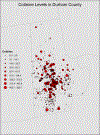Neighborhood Deprivation is Associated with Increased Risk of Prenatal Smoke Exposure
- PMID: 35179695
- PMCID: PMC9385886
- DOI: 10.1007/s11121-022-01355-7
Neighborhood Deprivation is Associated with Increased Risk of Prenatal Smoke Exposure
Abstract
Despite years of advisories against the behavior, smoking among pregnant women remains a persistent public health issue in the USA. Recent estimates suggest that 9.4% of women smoke before pregnancy and 7.1% during pregnancy in the USA. Epidemiological research has attempted to pinpoint individual-level and neighborhood-level factors for smoking during pregnancy, including educational attainment, employment status, housing conditions, poverty, and racial demographics. However, most of these studies have relied upon self-reported measures of smoking, which are subject to reporting bias. To more accurately and objectively assess smoke exposure in mothers during pregnancy, we used Bayesian index models to estimate a neighborhood deprivation index (NDI) for block groups in Durham County, North Carolina, and its association with cotinine, a marker of smoke exposure, in pregnant mothers (n = 887 enrolled 2005-2011). Results showed a significant positive association between NDI and log cotinine (beta = 0.20, 95% credible interval = [0.11, 0.29]) after adjusting for individual covariates (e.g., race/ethnicity and education). The two most important variables in the NDI according to the estimated index weights were percent females without a high school degree and percent Black population. At the individual level, Hispanic and other race/ethnicity were associated with lowered cotinine compared with non-Hispanic Whites. Higher education levels were also associated with lowered cotinine. In summary, our findings provide stronger evidence that the socio-geographic variables of educational attainment and neighborhood racial composition are important factors for smoking and secondhand smoke exposure during pregnancy and can be used to target intervention efforts.
Keywords: Bayesian analysis; Neighborhood; Smoke exposure; Socioeconomic status.
© 2022. Society for Prevention Research.
Conflict of interest statement
Conflicts of interest/Competing interests: The authors have no conflicts of interest to declare that are relevant to the content of this article.
Figures



References
-
- Adams EK, Markowitz S, Kannan V, Dietz PM, Tong VT, & Malarcher AM (2012). Reducing prenatal smoking: the role of state policies. American Journal of Preventive Medicine, 43(1), 34–40. - PubMed
-
- Bailey BA (2006). Factors predicting pregnancy smoking in Southern Appalachia. American Journal of Health Behavior, 30(4), 413–421. - PubMed
-
- Benowitz NL, Bernert JT, Caraballo RS, Holiday DB, & Wang J (2009). Optimal serum cotinine levels for distinguishing cigarette smokers and nonsmokers within different racial/ethnic groups in the United States between 1999 and 2004. American Journal of Epidemiology, 169(2), 236–248. 10.1093/aje/kwn301 - DOI - PubMed
-
- Bernert JT, Jacob P, Holiday DB, Benowitz NL, Sosnoff CS, Doig MV, Feyerabend C, Aldous KM, Sharifi M, Kellogg MD, & Langman LJ (2009). Interlaboratory comparability of serum cotinine measurements at smoker and nonsmoker concentration levels: A round-robin study. Nicotine & Tobacco Research, 11(12), 1458–1466. 10.1093/ntr/ntp161 - DOI - PMC - PubMed
Publication types
MeSH terms
Substances
Grants and funding
LinkOut - more resources
Full Text Sources
Medical

